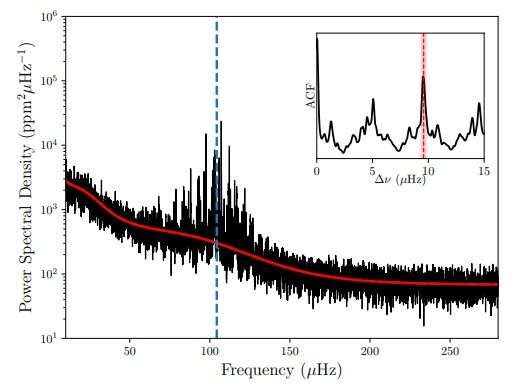May 13, 2019 report
Study unveils detailed properties of the eclipsing binary KOI-3890

By combining transit photometry, radial velocity observations, and asteroseismology, astronomers have gathered important information about the properties of a highly eccentric, eclipsing binary system known as KOI-3890. The new findings are presented in a paper published April 30 on arXiv.org.
Eclipsing binaries with red giants exhibiting solar-like oscillations are a rare find. When searching for new systems of this type, astronomers are especially interested in finding ones that showcase ellipsoidal variations in their light curve caused by large tidal distortions of the surface of the star during periastron. Due to these variations, such binaries were dubbed the "heartbeat" systems.
Heartbeat systems with solar-like oscillations can be characterized in great detail using radial velocity data and by conducting astroseismologic studies. For instance, astroseismology enables determining the obliquity (the angle between the stellar rotation axis and the angle normal to the orbital plane) of these systems and stellar parameters of their oscillating red-giant primary components.
KOI-3890 (aka KIC 8564976 and 2MASS J19350531+4438185) has been initially classified as a potential planet-hosting star. However, follow-up observations show that it is a heartbeat system—in particular, a highly eccentric 153-day-period eclipsing binary consisting of a red giant showing solar-like oscillations and an M-dwarf companion.
A team of astronomers led by James Kuszlewicz of Max Planck Institute for Solar System Research in Germany decided to conduct a comprehensive study of KOI-3890 using various methods to reveal detailed properties of the system.
"In this work, we aim to derive the properties of the components of an eclipsing binary system through the use of asteroseismology, eclipse fitting and radial velocity analysis. In addition, we aim to constrain the geometry of the system by inferring the inclination angle of the red giant primary to then obtain the obliquity of the system, which gives information as to whether the system is aligned," the researchers wrote in the paper.
The study found that red giant KOI-3890 A is almost six times larger than the sun (5.8 solar radii), but its mass is comparable to that of the sun (1.04 solar masses). The M-dwarf, named KOI-3890 B, was found to be approximately four times smaller and less massive than our sun (0.26 solar radii and 0.23 solar masses).
Astroseismic studies of KOI-3890 allowed the team to calculate the system's age. They found that the binary is about 9.1 billion years old. Moreover, astroseismic analysis revealed that the inclination angle of the rotation axis of KOI-3890 A is approximately 87.6 degrees. When it comes to the obliquity of the system, it was estimated to be at a level of approximately 4.2 degrees, which means that the plane of the orbit of KOI-3890 B is perpendicular to the stellar rotation axis of the primary star.
In addition, the astronomers estimated that the orbital eccentricity of KOI-3890 is about 0.61 and that the stars are separated from each other by around 0.19 AU. They also drew some conclusions regarding further evolution of the system.
"As the primary continues to evolve the M-dwarf may become embedded in the expanding envelope, leading to mass transfer between the stars in a common envelope phase. Additionally the strong drag forces on the secondary in such a configuration may lead to the ejection of the common envelope, and a significant decrease in the orbital period," the researchers concluded.
More information: James S. Kuszlewicz. KOI-3890: A high mass-ratio asteroseismic red-giant+M-dwarf eclipsing binary undergoing heartbeat tidal interactions. arXiv:1905.00040 [astro-ph.SR]. arxiv.org/abs/1905.00040
© 2019 Science X Network




















